 |
| Tibetan restaurant kitchen. |
I sighed as we rounded the last pinched curve to arrive at Immigration at Zhangmu, the border town of Tibet and Nepal. It is THE way to cross by road. A border crossing is called a “kasa”. And at this spot the Friendship Highway which rolls through China and Tibet beginning at Beijing ends. (The other course is to take the once a day flight to Lasha from Kathmandu.) I sensed that we had really been blessed to be in Tibet but that there will soon be no more opened arms from the China government. Rumors swirl. More and more restrictions are being put on granting visas. China really does not need the rest of the world to come peeking at its sights. Tourism among the China people is sufficient to fill the coffers without having to deal with foreigners.
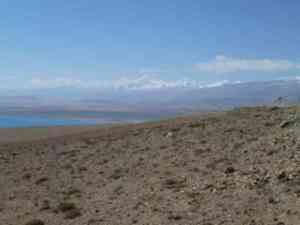 |
| Startling views in Tibet. |
Mostly, I am not surprised but rather sadden that not once did I hear about the 14th Dalai Lama. His name is off the records. I never saw a photograph of him, although other Dalai Lamas are pinned to the Buddha images and temples all over. On going through customs, very curt military – who don’t understand a thing one says – go through your belongings mostly looking for Dalai Lama 14 images. If they discover a book on him or with his photo, they will confiscate it. This is what they hunt for. With the recent incident of two monks setting themselves on fire, things tightened for all foreigners and although it was not pumped up or played on Chinese television, one could feel a sense of over-inspectionism. Plus, the enormous event of Saga Dawa was always a possibility of some sort of uprising when so many Tibetans gathered together so the small town of Danchen was loaded with police and soldiers. In comparison to our tough muscular protectors in USA, these forces looked so young, so small, though fit, and carried scowls on their faces. I think the point was to present a threat, a preventive.
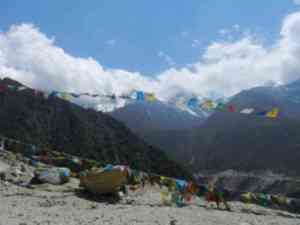 |
| Everywhere we go, prayer. |
Every day we were on the road, and every day we were in the car driving long distances, except the three days trekking on Mt. Kailash, the thorn in the trip was the constant check points. We are way out in the middle of beautiful nowhere, snow covered mountain tops exciting our senses, and there is a crude railroad crossing bar kind of thing causing us to stop. It’s a check point. Some even had police statues that held a stop sign. We were not allowed to photograph anything to do with these stopping moments. Tashee, our guide, carrying a huge brief cases of documents – you wouldn’t believe the papers required of him and us – would jump out with the drivers and go to a small window on a sort of ramshackled building in some cases, but serious police station in others, and join usually a small crowd of other drivers to wait while the officer inside hand-wrote the details. Sometimes we all had to get out to see that we were who we are on our passports. Sometimes the line of cars was long – and believe you me, there wasn’t much traffic on those long well-kept roads in Tibet. Sometimes the inspectors wanted us to open the trunks – packed with luggage – and sometimes they’d step on the rim of the car and look into the windows as if we were carrying contraband. They were not looking for bribes, as in many countries There were fees to pay. And if you were visiting say Mt. Kailash, they’d charge you for a ticket that was twice as as long as a folder and vigorously illustrated with photos. You never knew what the “cause” might be for the check point.
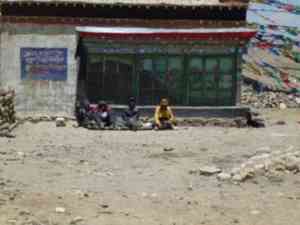 |
| Salesmen on the last pass. |
Our long drive from Saga (which is a bustling town in the midst of being constructed into something important for China – but isn’t there yet ) to Zhangmu was a struggle with extreme dust. About 40 miles at the start was over a seriously dusty road. We weren’t the only travelers headed for the border town. Some of the groups we had seen at Kailash and other points were also in the departure mode. As usual, the landscape was barren, with hundreds of sheep the same color as the desert-like ambiance, occasional Yaks grazing, and no trees or plants, but always the Himalayas on the rim. Then we climbed up serious swing-backs till we got to Tungla Pass, the last one for us, at 16,600 ft., strewn with many prayer flags (as all passes are) and sadly looking pretty unkempt and scruffy. The cold wind kept us in our well insulated jackets. Here we crossed the watershed between North and South side of the Himalayas. From here we go rapidly down in altitude and we find our first trees. In a few minutes after Nylanu, we are in a huge gorge, bigger than that in Colorado and rushing with all its strength in between the two precarious mountains is the river runoff of the glaciers of Shishipamgne. My gosh, we arrive in a rain forest of ferns and pines galore. But the road is a whopper – about a lane and a half, and curving like a stretches Slinky. Prayer flags are still strewn across unfriendly cliffs and places. Some one has a courage to do that.
 |
| The exit gorge in Tibet. |
About 5 p.m. we arrived at Zhangmu, which is sort of a poor man’s version of the Italian Riviera – all buildings are clinging to the rocks of this earth, and look like they’d crumble if an earthquake shook. The main street (only one) is so tight it’s a town activity when a truck needs to pass a truck and it takes a while to get anywhere. At least we were going downhill. Our hotel was very Chinese in interior and the rooms were medium. Everyone in it was also looking to get across the border into Nepal.
 |
| What a difference a turn makes. |
We rose at 7, ate a strange breakfast, loaded the two cruisers and headed for the customs and immigration at the border. We curved down to the river level. Joyfully, we were second in line. We off loaded all the luggage for our group of four and claimed our spot. In front of us was a small Russian group we’d bumped into often . It was 8:15 in the morning. Border control doesn’t even open until 10 a.m. But within a half hour, when all the hundreds of Indians arrived (we had anticipated that as they were also always in our wake or we in theirs), there was a line-up as if for playoff tickets. I sat on a bag and did needlepoint until finally the doors opened and we dragged all our stuff to the security folk. It was confusing. When we got through their process – and NEVER do you get a stamp that you entered or left Tibet – they had to check our American passports specially – but we were outside in an enclosed area. Porters surround us to lug our bags through the next phase as we said goodbye to Tashee and the two drivers. Then, just like in the movies, we walked across a bridge over that raging river to arrive in Nepal. And we were two hours and 15 minutes behind China time. From here on everyone drives English style, driver on the left.
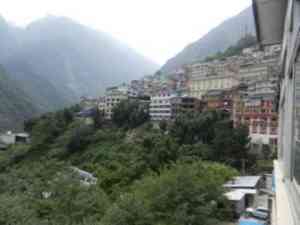 |
| Poor man’s Riviera. |
Oh how the scenery changed. Complete disorder. Everyone laughing and pushing and trying out their bits of English. Immigration on that side was a zoo. We had to get another visa because our 15 day one had ended that day. Pay $25 and fill out forms. Done. Easy. Then the long long drive to Kathmandu again on a suicide type of road hardly wide enough for our Hummer-like vehicle. Chickens in the road, and ducks, and geese, and calves, and toddlers and children in clean school uniforms. How do parents teach those little ones to not wander in the dirt and rock strip of road where cars and trucks pass at death-defying speed, tooting the horn all the way? Men sat around open air tables doing nothing. Women in bright saris were washing clothes in the hamlet’s only faucet. I wonder if there are many accidents?
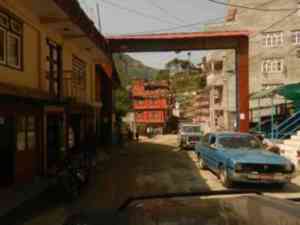 |
| Nepal! Back again. |
Oh the bouganvilla! Oh the fear of the oncoming bus speeding as if he was on a freeway. Does anyone flip over the very precarious cliff always on my side? Our driver was the opposite of the one in Tibet. He was fearless and really believed in his horn. I thought he’s going to kill somebody or us. Our task was to cover the 80 miles to Kathmandu. It would take at least three hours if traffic is light. It was. We stopped at the Riverside Highway Restaurant in the village of Shidhupalchowa , about 40 miles from our destination, because the driver wanted to eat his Indian breakfast. The Indian influence is evident from the start. We obliged. Then Jim pointed out to me that all along the road cannibas was growing and no one batted an eye. He said that was what had brought the Hippies to Nepal in groves during the late ’60s and early ’70s.
When we thought we were going to make our Hotel Malla alive and well, stopped at a crowded stoplight where about 30 motorcycles were crowded around us waiting for “Go”, the car died. Overheated. We had to sit for an hour in dusty, noisy confusing as the driver waited for the vehicle to cool down. Now we are in hot country. Crowded. Congested. Alive with people. Oh yes, we went through three check points, very informal, the guys in blue and gray camouflage were more curious about the car, I think, than us. I snapped a photo of a better stop point by accident. In Tibet, that’d be trouble.
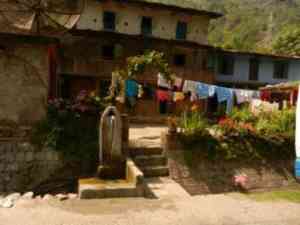 |
| Typical Nepal |
